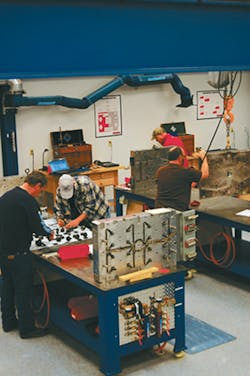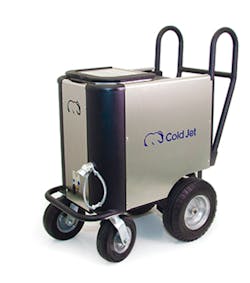Special Report: From data tracking to cleaning, mold maintenance yields productivity
Unless a mold is frozen up, broken or producing bad parts, it can be hard to know when or whether to perform maintenance.
Steve Johnson, owner of ToolingDocs LLC, Ashland, Ohio, said he has dealt with thousands of people in the plastics processing industry, and they invariably maintain molds reactively in what he calls a "firefighting" mode. However, Johnson said real money can be saved in avoiding breakdowns.
Johnson's mantra: Efficiently produce quality parts on time. That might not seem directly related to mold maintenance, but to Johnson, production depends on mold maintenance.
To better handle data, Johnson developed MoldTrax. The software tracks the performance, maintenance efficiency and repair costs of tooling. Users can select from drop-down boxes to describe issues and fixes; they can also attach images to the documentation. Johnson contrasted this approach, using shared terminology, with other products' free-form boxes, in which technicians themselves determine the quality and quantity of detail they provide. The MoldTrax data, he said, is more standardized and can be more easily analyzed over time.
"You're continually looking — or should be looking — at the history of the tool, the issues that it's had," said Johnson. "If we don't do this, then we have a tendency to make the same mistakes, fight the same issues over and over again." By tracking and analyzing tool history, users and technicians can better understand how to fix and prevent problems, and learn to identify the characteristics that can lead to problems. Johnson said the approach also helps provide data about personnel performance.
Since being updated in 2014, MoldTrax 6, also known as MT6, features many new functions and capabilities, including a parts inventory system, a tips section for easy access to manifold maintenance and repair instructions and a report that provides reminders about upcoming and overdue maintenance. With a new performance report, users can get important data, such as information about mold stops, at a glance.
"Of all the things that we should track, tracking our scheduled vs. unscheduled stops is where we should start," Johnson said. In analyzing their downtime, some processors realize about 80 percent of their mold stops are unscheduled; Johnson said ideally, unscheduled mold stops make up only about 20 percent of all mold stops.
To help companies optimize their maintenance efforts, ToolingDocs also offers a maintenance capabilities assessment (MCA), which it uses to create action plans to help molders better maintain their molds. The assessment scores companies on five factors — leadership, shop design, maintenance strategy, documentation and shop skills — and ToolingDocs provides recommendations for improvement. The company says using information gleaned from the MCA, molders have reduced unscheduled mold stops by as much as 50 percent and labor time by as much as 10 percent.
ToolStats, Warren, Mich., also provides tracking tools. Business development manager Sean Brolley said his company is out to change the way tooling data is stored and shared throughout the industry. Through a cloud-based application, the company provides a way for tool makers and users to append and track data about their tools. They can share information about the design, construction and use of the tool throughout its life, relying on an archive of data accessible by a bar code affixed to the tool.
"What we are trying to do is just guarantee that all the maintenance history is available with the mold," Brolley said. With the bar code created by ToolStats, the tool is never isolated from its data, saving designers, technicians and users the hassle of searching for information that would otherwise be kept in books or mobile electronic storage devices, such as flash drives or CDs. Brolley noted that the more traditional approaches to storing mold data can be easily lost or damaged and are much harder to update and share across personnel teams and plants.
If there is a problem with the mold or tool, users can scan the bar code to log the issue, track repair costs and store pictures or videos documenting the issue. That information can then be communicated instantly to all the teams involved with using the mold. Other alert and notification features are also available to make sure users never miss scheduled maintenance.
Brolley said that while ToolStats has created new apps for its platform, it is now focused on launching an entirely new version, with even more tools for communication, connectivity and collaboration. That version, which is slated to come out later this year, also will have greater functionality for scheduling maintenance and tracking important activity dates, as well as new program-management tools for the build process.
Brenda Clark, engineering manager, Hasco America Inc., Fletcher, N.C., said that with the new A 5800 mold memory, Hasco is taking a key step in the direction of digitized production. Since the start of the year, the hot runner division has been equipping all H4400 hot halves with the data storage unit, which can be flush-mounted to the mold. Similar products are available through other companies.
Cleaning up
Cleaning the tool is also important. Some of the common approaches include ultrasonic cleaning and dry-ice blasting.
As Dieter Stais, program manager for Marquardt GmbH, Rietheim-Weilheim, Germany, said in a case study about dry-ice blasting, "Clean tools are a must for the product quality." Stais said that using an i3 MicroClean-S4 dry-ice cleaning unit from Cold Jet, Loveland, Ohio, reduced cleaning time by 95 percent and improved process consistency.
"Compared to the four hours we had before, the productivity is increased significantly," Stais said in the Cold Jet case study.
Cold Jet's portfolio also includes the Aero series, which it updated last year. Two of the machines — the Aero 40FP and Aero 80FP — now have larger blast hoses and an upgraded blasting gun to provide full-pressure blasting. They also have a new feeding system, which reduces wear on the pads and rotor, and a more compact motor. They clean safely, without any abrasive chemicals.
Other manufacturers tout the strengths of their ultrasonic cleaning systems. According to Philippe Vaudeleau, president of Fisa North America Inc., Elk Grove Village, Ill., the approach is the most efficient cleaning method for mold components. It uses ultrasonic waves to agitate a liquid, creating tiny bubbles around all surfaces, crevices, grooves, channels and blind holes. He cited reduced downtime as a benefit of the approach. One customer in Buffalo Grove, Ill., who was cleaning a 192-cavity stack mold by hand, reduced cleaning time from two weeks to two days by using a customized Fisa alveolar magnetostrictive ultrasonic technology and a specific water-based detergent.
"The combination of these products makes mold cleaning efficient, fast and safe," Vaudelaeu said.
The thermal, chemical and mechanical properties produced by the waves combine to remove residual polymers and mold releases from mold components, giving them a longer lifespan than molds cleaned with traditional methods. In addition, ultrasonic cleaning is capable of removing buildup from internal cooling ports and channels, thereby improving polymer flow. The approach does not require the aggressive cleaning compounds typically used by other methods.
"The end result of cleaning injection molds with ultrasonics is the end user will experience longer mold runs, consequently improving the overall efficiency of their process," said John Hurley, director of commercial products at Branson Ultrasonics, Danbury, Conn., which is a business of Emerson.
Branson's S-8500 is one of the company's most popular units for cleaning injection molds. It has even proved itself when working with newer technologies, such as 3-D printers. The unit has a heated stainless steel tank, 25 kilohertz power supply and several immersible ultrasonic transducers.
Branson injection mold cleaning tanks are available in standard as well as custom configurations. Tank sizes can vary from tabletop units for small mold components or segments to much larger tanks that can be used for entire mold plates or larger molding operations. In addition, a recirculating pump and filter are available to remove particulates from the cleaning solution as they are cleaned from the mold components.
Jeff Hancock, sales director of Blue Wave Ultrasonics Inc., Davenport, Iowa, said his company's ultrasonic cleaning systems eliminate 50-80 percent of the labor and 100 percent of the hazardous airborne solvents and damaging abrasives required to manually clean tools.
Blue Wave Ultrasonics backs every system with a lifetime transducer and radiating diaphragm warranty, as well as a 20-year guarantee against weld failures and erosion of the ultrasonic tank.
Merle R. Snyder, senior correspondent
Contact:
Blue Wave Ultrasonics, 563-322-0144, www.bluewaveinc.com
Branson Ultrasonics, 203-796-0400, www.bransonic.com
Cold Jet, 513-831-3211, www.coldjet.com
Fisa North America, 847-299-8400, www.fisa.com
Hasco America Inc., 828-650-2600, www.hasco.com
ToolingDocs LLC, 419-281-0790, www.toolingdocs.com
ToolStats, 586-408-9199, www.toolstats.com


